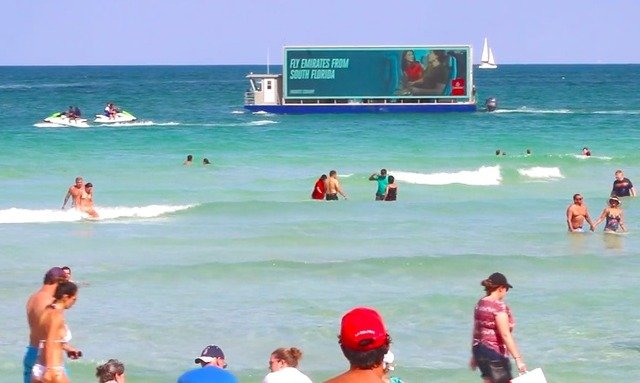'Times Square-Style' Billboard Boats Could Target NYC Beaches This Summer
May 10, 2019, 9:10 a.m.
The company's CEO won't rule out the possibility of crashing the city's beaches this summer, as he has done in Miami.

What, you <em>don't</em> want to spend a pleasant day at Jacob Riis splashing in the wake with Emirates Airline?
It's been half a year since Ballyhoo Media's floating billboards began pointing LED video ads at New York City's waterfront, and more than a month since the de Blasio administration sued to "put a stop to it." But despite an ongoing court case and the threat of six-figure fines, the 1,200 square foot double-sided screens remain a "floating eyesore" on the Hudson and East Rivers. More worrisome, the company's CEO won't rule out the possibility of crashing the city's beaches this summer.
Court documents offer some insight into Ballyhoo's strategy for fighting back at the city, employing a mix of alleged disobedience and legal maneuvering that's allowed the company to remain in parts of Miami years after local officials tried to run them out of town.
Back in March, in response to growing complaints from New Yorkers, Mayor Bill de Blasio filed a lawsuit against the company, arguing that the boats violated a decades-old zoning resolution prohibiting advertising on local waterways. A few weeks later, the city petitioned Judge Louis Stanton to issue a preliminary injunction barring Ballyhoo from operating within 1,500 feet of the city's shoreline as the case proceeds. Judge Stanton—who, fun fact, was a merchant marine during World War II and, at 91 years old, had taken senior status before being called back to the bench for this case—granted the request.
When the city's Law Department geo-tracked the barge, however, they found that Ballyhoo wasn't following the judge's orders. In a letter to the court, Ballyhoo acknowledged that they'd at times been forced to breach the invisible 1,500-foot boundary in order "to maintain safe navigation procedures." Their attorneys claimed that their boat captain had turned off the LED screen whenever this happened.
"Ballyhoo has been totally compliant, and will continue to comply, with the terms of the preliminary injunction issued by the Court," the company's CEO, Adam Shapiro, wrote in an email to Gothamist.
But evidence collected at the scene seems to indicate otherwise. Try to ignore the comedian groaning and pretending (?) to urinate here—does this look like 500 yards to you?
TV BOAT pic.twitter.com/FvtOLX2mHF
— Conner O'Malley (@conner_omalley) May 2, 2019
Something else strange happened on May 2nd. On the company's request, the judge's initial injunction was modified with seven new words: "Ballyhoo is enjoined from conducting any of its water-borne advertising operations under 1,500 feet from the City's shore and within view from an arterial highway."
As far as the city's Law Department is concerned, the revision was basically meaningless; since the barge makes its trips around the lower half of Manhattan, and seeing as how most of that route is adjacent to a highway, Ballyhoo was effectively still banned.
"Ballyhoo fails once again to demonstrate that there is any location that is not 'within view' of an arterial highway," wrote NYC Corporation Counsel Zachary Carter in his response to the injunction. "Ballyhoo likewise fails to submit any evidence that its digital advertising barge is capable of reaching a location out of view of any arterial highway—if such a location exists—without violating the Zoning Resolution while it is in transit to that location."
But Shapiro has a different interpretation. In an email to Gothamist, he framed the amended injunction as a victory (emphasis his): "The Court held that the subject zoning regulations do not apply to any water-borne advertising conducted outside of 1,500 feet from the City's shoreline, and to any water-borne advertising that is not within view from an arterial highway—regardless of their distance from the shoreline."
In other words, Shapiro believes the boat can now sail wherever it pleases along the city's waterfront—the southern tip of Manhattan, Brooklyn Bridge Park, even the Rockaways—so long as you can't see it from a nearby highway.
Asked whether he planned to keep the barge on its current trajectory, or whether there he might consider extending its route to the city's public beaches, as he has done in Miami, Shapiro declined to comment, except to say that "we have no plans to leave the city." He then accused Gothamist of "bashing my company."
A spokesperson for the Law Department said that Ballyhoo has a deadline of May 15th to respond to the city's original complaint.
The city's beaches open for swimming on May 25th.